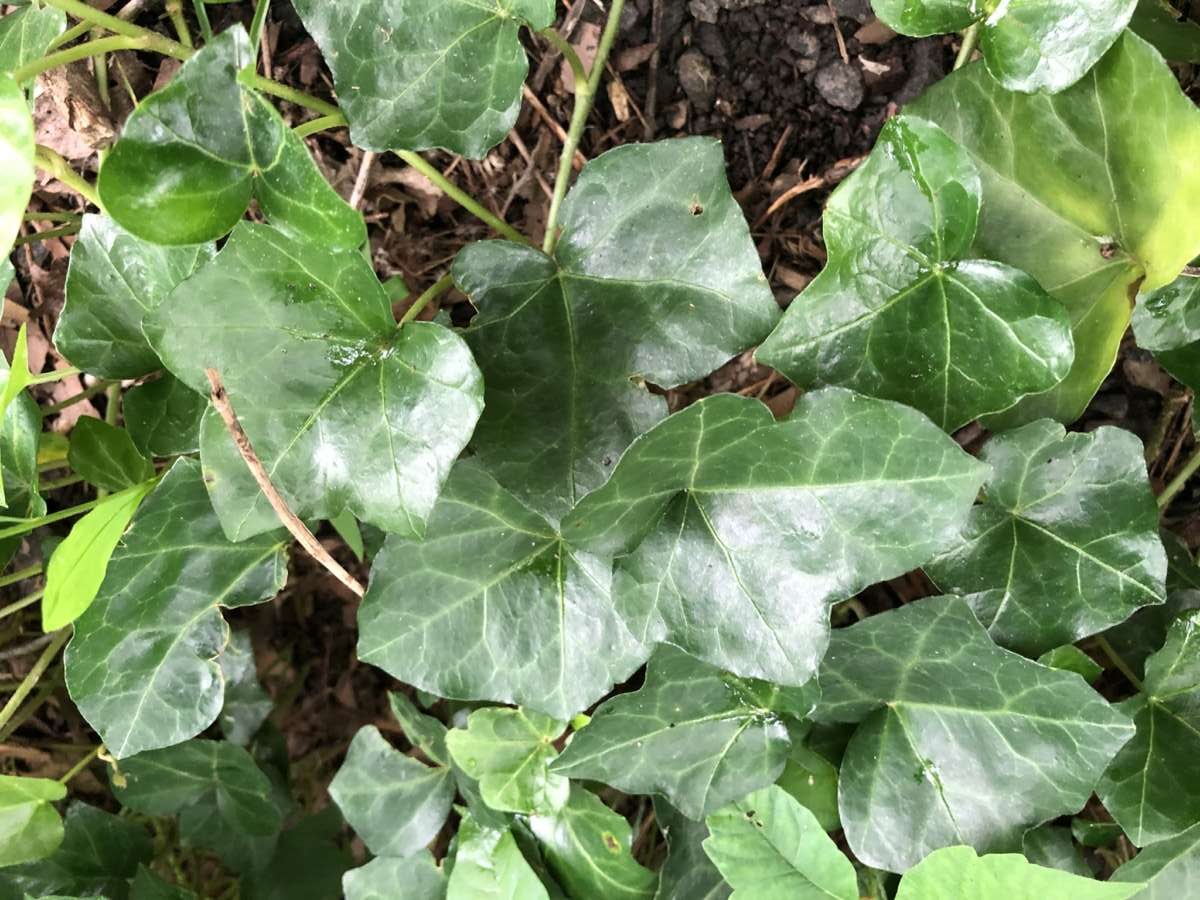
In the latest round of action on bills, Virginia Gov. Glenn Youngkin signed 100 bills passed by the Virginia General Assembly, including one to protect Virginians from unlawful discrimination, hate crimes and antisemitism. The governor vetoed four others, including one to create civil penalties for shop owners who fail to advertise they are selling invasive plants that could harm other species.
Among the 100 bills signed is a measure that will codify a recommendation by the Commission to Combat Antisemitism that Virginia revise its laws to better protect Jewish citizens from hate crimes, along with Muslims, Sikhs and other ethnic-religious groups.
Youngkin said the legislation aligns with one of his top priorities: combating antisemitism.
“As the first state to weave religious freedom into the fabric of our nation, Virginia is leading once again and sending a clear message that Virginians should not be the victim of a crime simply because of their religion, race, or ethnicity,” the governor said in an April 2 press release.
Sen. Bryce Reeves, R-Spotsylvania, and Del. Dan Helmer, D-Fairfax, carried the legislation, Senate Bill 7 and House Bill 18.
“I’m thankful for the governor’s signature and the bipartisan co-patrons of this important bill,” said Reeves in a statement. He added that legislation outlawing antisemitism isn’t just about protecting a particular group, but about “defending the fundamental values of equality, justice, and human dignity for all.”
Helmer, a descendant of Holocaust survivors and a Jewish man whose children “confronted antisemitism” in school, Helmer said the legislation is important to him.
“Hate has no place in our communities,” Helmer said in a statement, adding that he is grateful for the governor’s signature to “protect people of every ethnicity across the commonwealth.”
Other interesting pieces of legislation the governor signed into law include House Bill 143, which directs the Virginia Department of Transportation to create a publicly-accessible utility work database and map that details projects within state-maintained areas, excluding emergency maintenance and services to private properties. Another measure, House Bill 322, will create a Cosmetology Compact, which will allow people to be licensed to provide barbering, hair styling and other cosmetic services in Virginia and other states that join the compact initiative.
Vetoed legislation
The governor also vetoed four bills that would have required the state to adopt model public education policies on climate change and environmental literacy, permitted college instructors to request non confidential garnishment data for research purposes, and created penalties for shop owners who fail to identify invasive plants they sell.
In explaining why he rejected the bill on adopting model policies for climate change, the governor said the measure is already included in the Standards of Learning for students, and the proposal “imposes a significant and redundant task” on the Department of Education and the Board of Education. Read More
With the help of local developers and property owners, the Tysons Community Alliance is on a mission to beautify the green spaces found where many of the area’s major roads intersect.
The first site targeted is the southwest quadrant of the Route 7 (Leesburg Pike) and Route 123 (Chain Bridge Road) interchange, where the Vienna-based company Tyson’s Tree Service began clearing overgrowth, invasive plants and dead trees on Jan. 2.
Led by the affordable housing firm SCG Development, which is headquartered nearby at 8245 Boone Blvd, the clean-up effort will set the stage for the approximately 2 acres of land to be replanted with native species and new landscaping — a process that Tysons officials hope to repeat at other locations.
“I would almost call this a pilot,” TCA spokesperson Karyn Le Blanc said. “…We would want to take a look at this, analyze it and then, see where we can replicate it in other areas or take the best parts of what’s worked on this and use this in other areas as well.”
The idea for the Tysons beautification project came from SCG Development President Steve Wilson. After 35 years of traveling the local roadways as a Northern Virginia resident, Wilson noticed the accompanying open spaces and landscaping had gotten unkempt, and in December 2022, he “just decided something needed to be done about it,” he told FFXnow.
Tysons has about 140 acres of green space that go unmaintained, mostly around its six major interchanges where routes 7 and 123, the Dulles Toll Road and the Capital Beltway (I-495) meet. That amounts to 5% of the 2,743-acre area designated as Fairfax County’s urban center, per SCG.
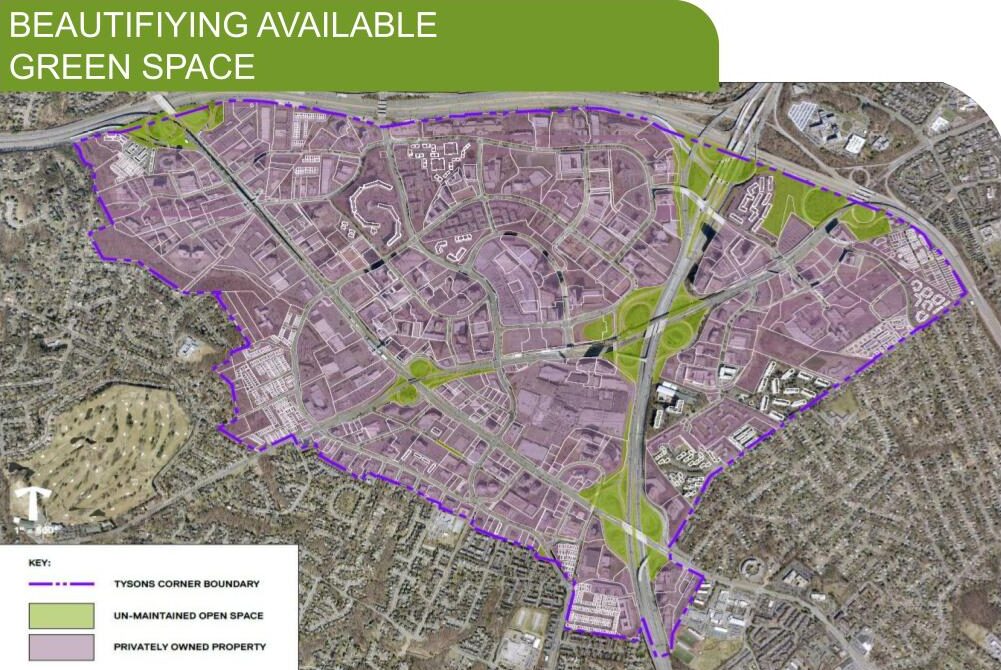
Arguing that cleaning up these areas would reduce safety concerns, encourage more pedestrian traffic and improve property values, the developer soon met with Providence District Supervisor Dalia Palchik, who represents most of Tysons, and offered to test its concept by sponsoring the Leesburg Pike and Chain Bridge Road interchange.
Once studied as a possible park, the site is “highly visible” and “perhaps the worst in terms of being overgrown,” Wilson says. He also highlighted its proximity to the Fairfax County Economic Development Authority, whose headquarters overlooks the interchange. Read More
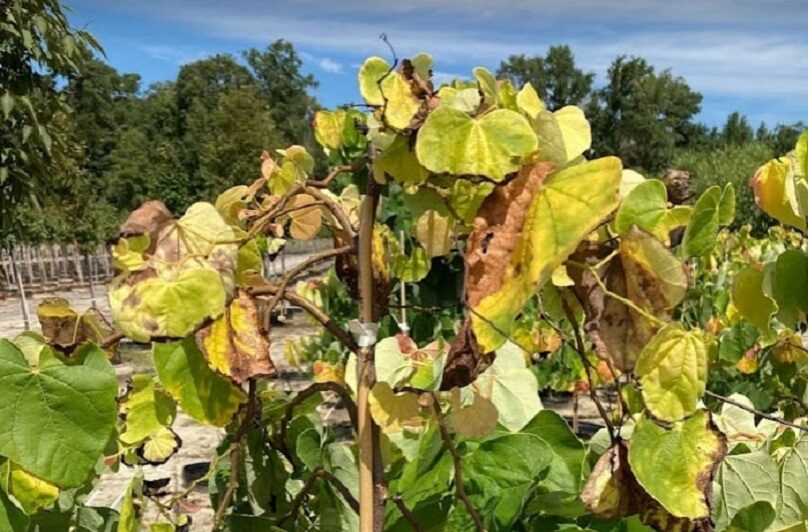
Any Fairfax County residents who recently bought a budding tree or shrub may want to keep an eye on its leaves.
A relatively new disease called vascular streak dieback is killing plants from nurseries in Virginia and five other states, the Department of Public Works and Environmental Services’ (DPWES) Urban Forest Management Division says.
“Dieback may look like yellowing or paling of the leaves’ green color (leaf chlorosis), brown or scorched leaf margins and stunting and/or wilting of current year’s growth,” DPWES said in a press release on Tuesday (Oct. 3).
In Virginia, the plants that appear to be most susceptible to the disease are maple, dogwood and redbud trees, according to Virginia Tech and the Virginia Cooperative Extension (VEC), which have cataloged 21 different affected woody ornamental plant species, as of March.
First detected in cacao in Papua New Guinea during the 1960s, vascular streak dieback was mostly confined to southeast Asia until the past couple of years. The Virginia Department of Agriculture and Consumer Services (VDACS) confirmed that the disease had emerged in the state last year.
Researchers have traced the disease to a fungus called Ceratobasidium theobromae, whose spores get carried from plant to plant by the wind, according to DPWES.
“After a spore infects a leaf, it travels into the branch and the main stem’s woody tissue, eventually killing the plant,” the department says. “Researchers continue to study VSD, and the fungus related to it, to find ways to prevent infection and the potential spread into the natural environment.”
Available data on how to prevent VSD is limited, but Virginia Tech and the VEC say it can help to minimize stress on plants by ensuring they have the right amount of soil, water and other conditions needed to stay healthy.
Here’s more from DPWES:
Virgina Cooperative Extension recommends that nurseries ensure best management practices of plant stock to prevent chances of infection. Residents looking for trees in nurseries may consider asking nursery staff about vascular streak dieback and if the internal woody tissue may safely be checked for VSD before purchasing. Also, look for any signs of scorched leaves and buds or dieback of young stems. If VSD is suspected in a recent purchase report it to the Virginia Cooperative Extension and dispose of the plant material correctly to prevent its potential spread. Plants, or the suspected live branches, also may be bagged and either taken or mailed to the Extension, where the disease can be positively identified. If mailing, a two-day delivery is best to avoid damage to live tissue.
The county’s urban forest management team has also been combatting a beech leaf disease that emerged in the area last fall and the invasive spotted lanternfly, which feeds on trees, shrubs and herbs “in unusually large numbers,” DPWES has said.
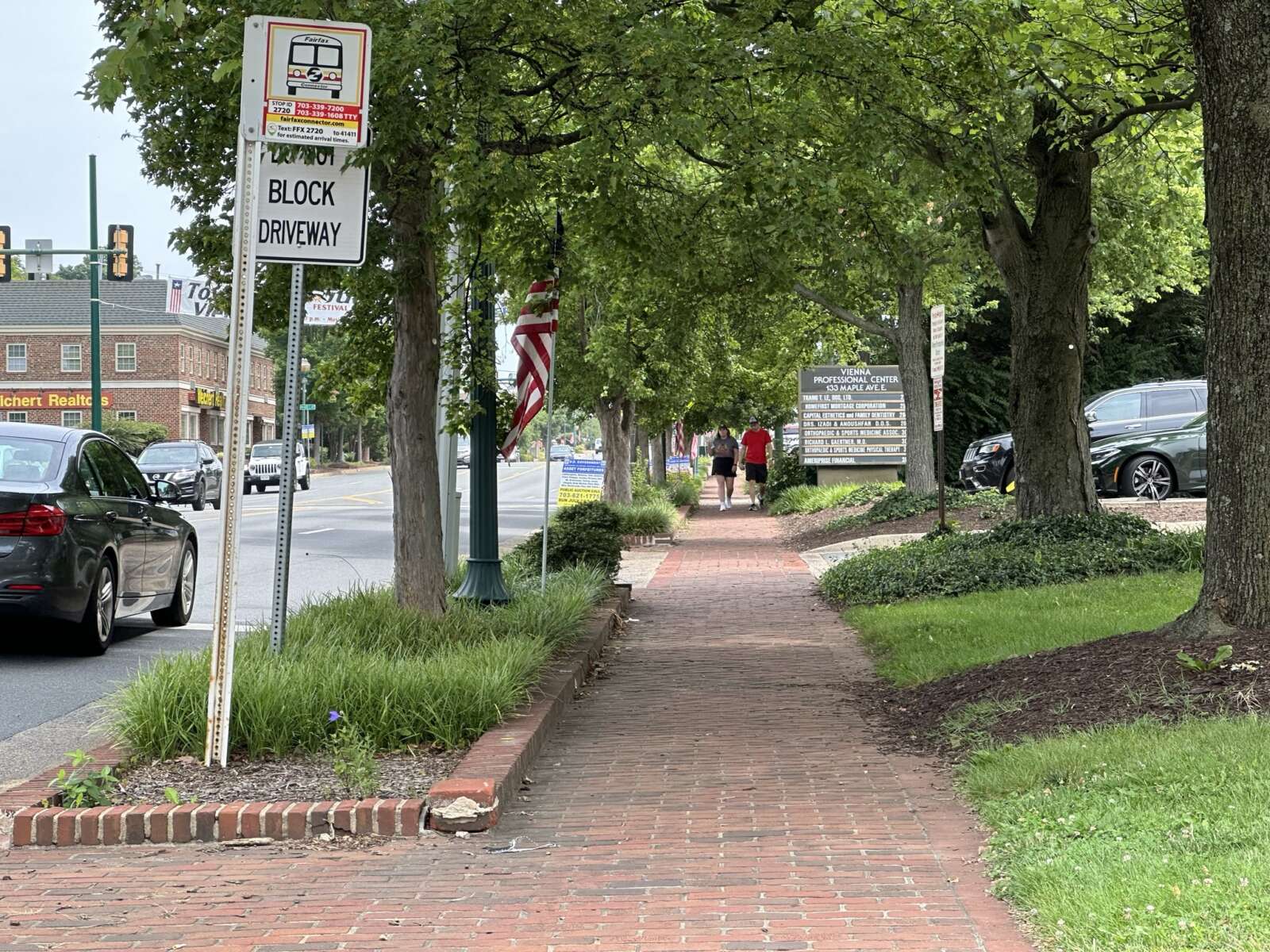
Generally speaking, florals for spring may not be groundbreaking, but the Town of Vienna is still counting on new flowers and shrubs to give its commercial corridor some seasonal pizzazz.
Landscaping crews began work yesterday (Thursday) to update the landscaping along Maple Avenue and Church Street for the first time in 20 years. The project is intended to “boost curb appeal in the business district,” according to the town.
“The plan calls for 81 landscape planters on both sides of Maple Avenue and 46 planters on both sides of Church Street to be transformed into a welcoming, vibrant display of seasonal color from spring to fall,” Vienna Parks and Recreation Director Leslie Herman said in a press release.
The initial work is focused on Maple Avenue between Courthouse Road SW and East Street NE, requiring lane closures from 9 a.m. to 3 p.m. through Monday (Sept. 25).
However, Herman says crews will typically remove plants and prepare the new planters between 8 p.m. and 6 a.m. to “mitigate the impact of lane closures on residents and commuters.”
Friendly Reminder: Crews will begin the Town's Streetscape project starting today, Sept. 21. Work will occur from 9 a.m.-3 p.m. on Maple Avenue, from Courthouse Road SW to E Street NE through Monday, Sept. 25. Expect lane closures around the work. More: https://t.co/QNPR5KOFAx. pic.twitter.com/Kk3qxxqcn2
— Town of Vienna, VA (@TownofViennaVA) September 21, 2023
Designed by contractor LSG Landscape with plants from Merrifield Garden Center, the project will replace all understory plantings on Maple Avenue with new shrubs, ornamental grasses and both perennial and annual plants, according to the town.
Most of the existing understory on Church Street will remain, but it will be supplemented by new plants with “similar colors and textures to create a more consistent appearance,” the town said.
While the project mostly deals with the underlying plants, it will also remove trees deemed to be in poor health, per the press release:
As part of this project, some trees that are in poor or declining condition will be removed. This will not only improve the health of the remaining street trees but also increase sunlight exposure and reduce root competition. To maintain the tree population, an equal number of new trees will be planted, enhancing both consistency and biodiversity.
A recent inventory determined that most of Vienna’s remaining trees are healthy, but the overall canopy has declined, prompting the town to consider new conservation measures. A proposal that would require developers to preserve more trees will go to the planning commission for a public hearing on Wednesday (Sept. 27).
The planting work on Maple and Church is expected to continue through Nov. 8.
“If all goes as planned, residents and visitors will start seeing the colorful results in spring 2024,” the town said.
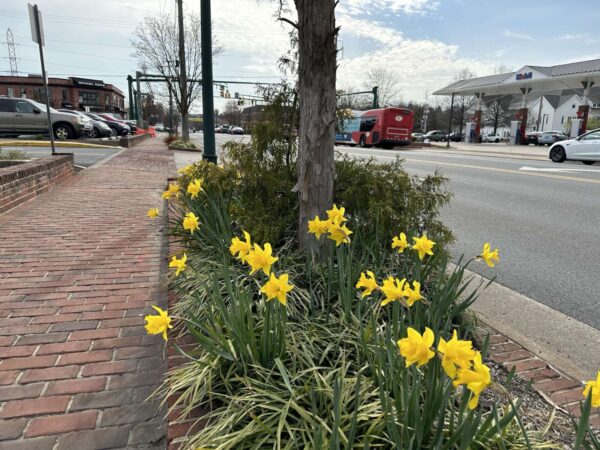
A new crop of plants will take root this fall along Maple Avenue and Church Street, the Town of Vienna’s main commercial roadways.
LSG Landscape Architects, a landscaping firm contracted by the town, will present its proposed design for the new planters next Thursday (June 29) after sharing the concept with the Vienna Town Council this past Tuesday (June 20).
The town is inviting residents, business owners and other community members to attend the informational meeting, which will take place at 6:30 p.m. in the Vienna Community Center (120 Cherry Street SE).
“Homeowners understand the importance of curb appeal, especially when they want to sell their homes,” Vienna Park and Recreation Director Leslie Herman said in a press release. “We’re working with the Town’s economic development department to create a similar dynamic to create a welcoming, vibrant commercial area that attracts residents and visitors and ‘sell’ them on supporting local businesses.”
LSG has proposed replacing or refurbishing 81 landscape planters on both sides of Maple Avenue between East Street and 213 Maple Avenue West, along with 46 planters on both sides of Church Street between Mill Street and Lawyers Road.
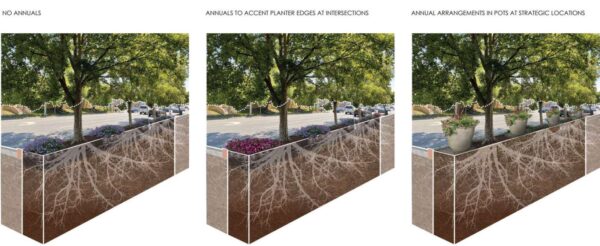
The project will focus on flowers, shrubs and other low-lying plants, but some trees may be removed if they’re in “poor condition” or “to allow more light and reduce root competition with the new plant installations,” town staff said in its recommendation to the council.
Replacing planters that were first installed 20 years ago, construction on the new landscaping is expected to begin in mid-September and finish by the end of November.
“If all goes as planned, the commercial corridor’s planters will begin to burst with color next spring,” the town said.
Vienna previously hoped to have the new plants in place by this summer, but in March, the town council argued that funds should be allocated separately for design and installation, rather than all at once, leading to a delay.
The contract of $83,445 was ultimately awarded to LSG on May 1. The town will conduct a second bidding process for a contractor to build and install the new planters in August and September, per a timeline provided by LSG.
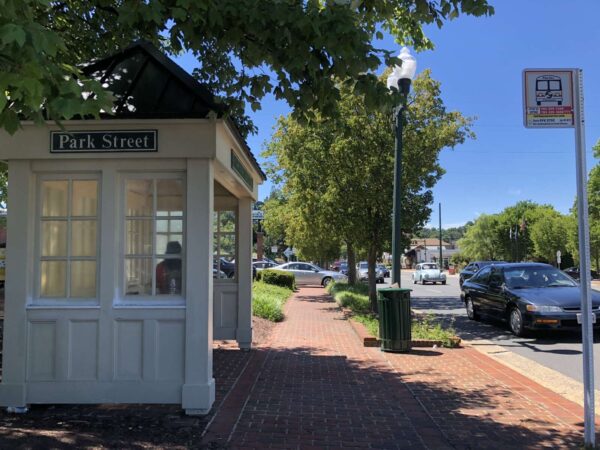
The Town of Vienna wants to bring more color to Maple Avenue and Church Street with a landscaping refresh, but new greenery won’t be in the ground until August at the earliest.
Department of Parks and Recreation staff approached the Vienna Town Council on Monday (March 20) to request $600,000 for a landscaping contractor that will help design and install new planters along the town’s main commercial streets.
However, uncertainty over how exactly those funds will be spent led the council to postpone a vote until its next meeting of April 10.
“Many of us have questions we’d like to get answers to,” Mayor Linda Colbert said.
Staff had hoped to get design options for the improvements this April and choose a final one in May so that the project could finish by the end of July, according to a request for proposals issued Jan. 12.
The town was seeking a vendor to design and install 81 landscape planters on both sides of Maple Avenue between East Street and 213 Maple Ave. West, along with 46 planters on both sides of Church Street between Mill Street NE and Lawyers Road NW.
The existing landscaping, including planters, brick sidewalks, streetlamps and bus shelters, was installed on both streets approximately 20 years ago, according to the town.
“The landscape plants have matured over the years and the uniformity of the design has waned,” the RFP said. “The trees are the predominant feature of the landscape planters while the shrub and herbaceous perennial layer is inconsistent and often absent.”
In addition to the actual plants, the requested funding would cover soil remediation, root pruning, the public engagement process, traffic control and sidewalk closings, and any needed removals of vegetation other than trees, which will be taken care of by town staff, Parks and Recreation Director Leslie Herman said.
The Tysons-based firm LSG Landscape Architecture, which previously assisted Vienna with a study of the Maple Avenue streetscape, was selected as the contract recipient.
Councilmember Chuck Anderson balked at the lack of details on the price of individual plants and other expenses, questioning why staff was seeking $600,000 right now when, so far, LSG has only provided a cost estimate of about $83,000 for the design portion of the project.
“I understand that the design’s not done, but we lack any leverage over pricing, so for the remaining $520,000, in theory, they could come up with whatever they wanted at whatever price,” Anderson said. “…This does not sound like to me to be sound contracting practices, particularly for a contract that’s this big. I think we need more certainty.”
According to Herman, the town believes having one firm design and install the project would be more efficient than doing separate RFPs, but after talking to LSG, staff decided they could get a more accurate estimate for the cost of implementation after the design is chosen.
Though initially skeptical, other council members ultimately agreed with Anderson that more financial information is needed after staff seemed unable to explain how they arrived at $600,000 as their proposed funding cap.
Despite her lingering questions, Colbert lauded the project’s overall goal of bringing more life and color to Vienna’s streets year-round.
“We’ve had residents come to us, email, come to our meetings and speak, businesses have talked to me about expecting Maple Avenue and Church Street to be greatly improved,” Colbert said. “It will help our businesses, and it will define our town better, I think, as people drive into town.”
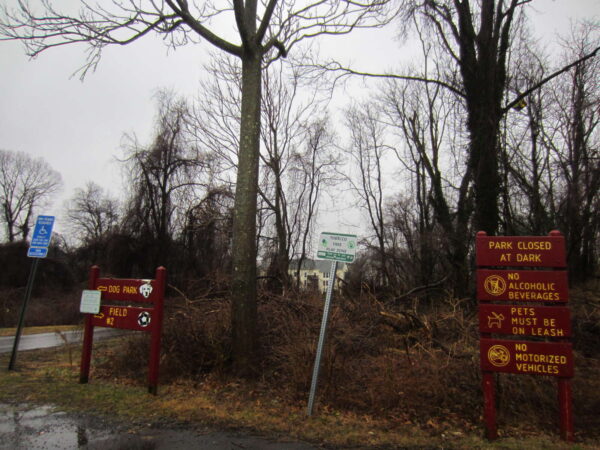
The Fairfax County Park Authority has some new financial muscle behind its efforts to clear invasive plants from Blake Lane Park in Oakton.
A $20,000 grant from the Dominion Energy Charitable Foundation will enable the agency to clear an additional 1.2 acres of land and replant it with native shrubs and trees, the FCPA announced last week.
The invasive plant removal efforts will specifically target Ailanthus altissima, also known as tree-of-heaven, a tree native to China and southeast Asia that got introduced to the U.S. in the 1700s.
In addition to being prolific and difficult to remove once it takes root, tree-of-heaven is a host for spotted lanternflies, according to the park authority. The winged pests secrete a honeydew substance that can attract other insects like wasps and ants and spur mold growth, ruining forests and crops.
Since a spotted lanternfly made its way to Fairfax County via a grocery store shipment in Annandale in 2021, the park authority has urged community members to kill the insects immediately.
According to the Jan. 4 news release, Blake Lane Park was chosen for the grant to the Fairfax County Park Foundation “due to the high density of Ailanthus altissima, and strong community volunteer support” for the FCPA’s Invasive Management Area program (IMA).
“Conservation and restoration of our parks and woodlands requires a communitywide effort and our Invasive Management Area program is a shining example of a community-forward approach to achieving those aims,” FCPA Resource Management Director Laura Grape said. “We are very grateful to Dominion Energy and to our community volunteers for their tremendous dedication to environmental stewardship and helping us make a lasting difference at Blake Lane Park.”
The grant went to the Fairfax County Park Foundation, which raises private funds and obtains grants for the park authority to supplement its public funding. The FCPA will match the grant to “provide long-term maintenance and community engagement” at Blake Lane Park, according to the release.
Located at 10033 Blake Lane, the 10-acre park features a forested trail, a dog park, two soccer fields and an open play area. It was targeted for development as a new elementary school, but resident opposition — and the realization that the Dunn Loring Center could be converted instead — nixed that plan.
The park is one of 65 sites in the IMA program, which recruits volunteers to help remove invasive plants and restore habitats. Program Manager Patricia Greenberg previously told FFXnow that 70 to 75% of the county’s parkland is covered by invasive species.
The park authority says the grant for Blake Lane Park will cover enough seedling purchases to plant 100 stems per acre.
“We know how important it is to care for our air, water, and land — including the wonderful parks in our communities,” Dominion Energy spokesperson Peggy Fox said. “We’re proud to support the Fairfax County Park Foundation with an education and stewardship grant to enhance our local parks.”
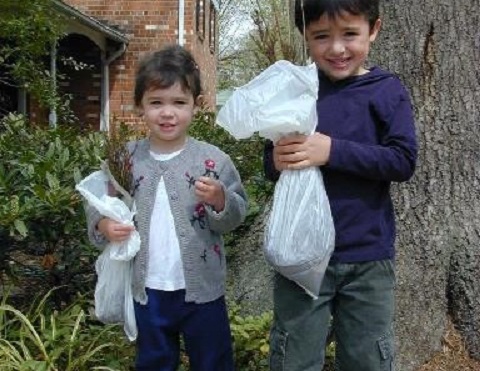
Fairfax County’s annual seedling sale begins at 10 a.m. tomorrow (Tuesday).
The Northern Virginia Soil and Water Conservation District sells the seeds through its Native Tree and Shrub Seedling Sale, but they often sell out in the first week.
“All species sold are native to Virginia and are important to bees, as well as serving as valuable food sources for wildlife,” the county said on an informational page.
The program was interrupted in 2020 by the COVID-19 pandemic and resumed last year with measures to reduce to the spread of the virus, such as no in-person purchases, mandatory mask wearing and contact tracing.
Those efforts are continuing this year, and customers will be able to pick up their orders from 9 a.m. to 4 p.m. April 1 and 9 a.m. to noon April 2 at the Sleepy Hollow Bath and Racquet Club (3516 Sleepy Hollow Road) in West Falls Church.
Customers are asked to limit orders to three packages. Each package gets six seedlings for $15. The packages this year are the following:
- The “Tree-mendous Flowers Package” has seeds for the American hornbeam and winterberry holly trees as well as the Canadian serviceberry shrub.
- The “Un-bee-lievable Blooms Package” has seeds for the eastern redbud tree as well as Indigo bush and silky willow shrubs.
“Don’t wait to place your online order at 10 am on Tuesday, March 1,” the Virginia Native Plant Society said in an online post. “All seedlings sold out quickly last year.”
Photo via Fairfax County

